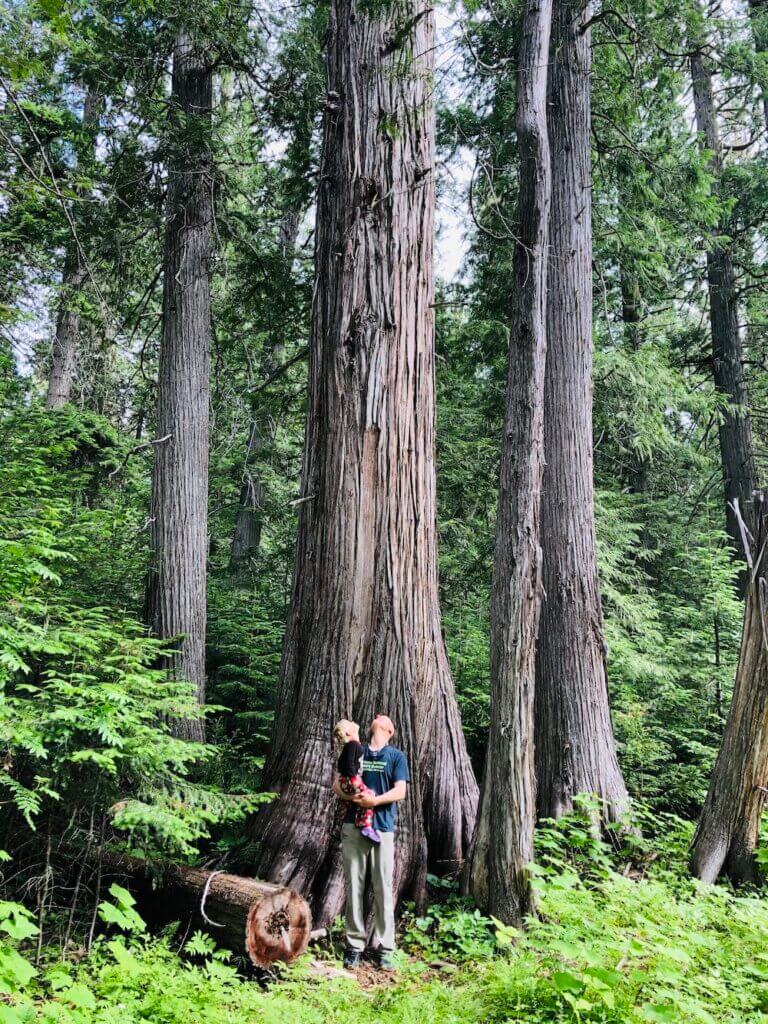We Speak In Smells
By Kayla Heinze
Broadcast 5.10 & 5.13.2023

Breathing in the cedars. Photo © Allison De Jong.
Listen:
Does your breathing feel easier in the forest, too? Alone with the trees, the snow melting tortuously slowly beneath my feet, I pressed my nose to a crack in the cedar’s peeling bark and inhaled deeply.
I could not articulate what pulled me off the trail, but I followed the urge all the way to the base of the towering tree, a western redcedar. I stood, neck bent back to take in its shading canopy of soft, scaly leaves. We greeted one another in an exchange that predates my ancestors taking human form: the mammalian exhale of carbon dioxide and inhale of oxygen from the trees.
It was a quiet communion. There was barely a breeze to shake the branches that embraced me and the creek flowed in a hush.
This tree has lived here for decades, its leaves shampooed in a bright lather of sunlight and rinsed with the cream of bird song. I traced my fingertips over the verdant new growth, imagining what other creatures had stopped in this same spot: squirrels tickling the cedar’s trunk and curious deer nudging through the understory.
I wondered if, and how, the tree takes note of us visitors, passing through. Does it sense the slight increase in carbon dioxide from my breath? Do its chloroplast-packed cells notice the sudden shade when I block the sun? As I filled my nose with the fresh, earthy musk of the cedar, I imagined we were speaking in a shared language.
And perhaps we were. They say smell is the only sense to become fully developed in the womb. This was my original way of communicating — my first language — and the cedar was speaking back.
You see, trees employ volatile organic compounds both above and below ground for a variety of signaling purposes. The majority of these compounds belong to a class of chemicals known as terpenes, which can be aromatic. Not only do their odors aid in forest-wide synergy by warning neighboring trees of threats, they can provide messages to a broad swath of organisms as a way to influence their interspecies interactions. Terpenes are detectable by animals, meaning trees can attract or repel would-be leaf-munchers, pollinators, and infectious agents.
Animals ourselves, is it such a leap to think that we too might be influenced by these silent forces?
The essential oil distilled from western redcedar is full of terpenes and considered beneficial for the body and spirit in herbal traditions rooted in the Pacific Northwest. The leaves are used as incense. Straight from the source, or distilled into these concentrated oils, the power of cedar’s terpene aroma is undeniable.
It makes sense. After olfactory signals arrive in the brain, they quickly travel along the roads of our winding neurons to the amygdala and hippocampus — areas that deal in emotion and memory, respectively.
Perhaps I was remembering an age before language when the only routes we had to understand one another were the quiet senses I tuned to on this day with the cedar, smell chief among them. Carbon dioxide, oxygen, volatile compounds, and likely other chemicals still beyond the reach of our science, bridging the gap between us.
My roots with these trees do not go as deep as those of communities who have lived on this land since long before industrial air pollutants grew heavy in the sky, altering the chemical composition of the tree’s emitted terpenes. Many Indigenous and First Nations peoples consider the western redcedar a “tree of life,” generous in offering shelter, medicine, transportation, spiritual guidance, and much more. Under the cedar’s emerald leaves, fluttering in the breeze with a sound like dreaming, I understood a fraction of those gifts and still felt overwhelmed.
That day in the woods, the animal in me wandered off the trail that had been set. I was not cognitively aware as it happened, but I suspect I was pulled by some deep, genetic memory of relying on smell to speak across the vast silence separating human and plant.
I was longing to talk with the trees and, as I stood there with the cedar, my lungs sustained by the fresh air it provided, I knew there was more to say than I could have even imagined.
Every week since 1991, Field Notes has inquired about Montana’s natural history. Field Notes are written by naturalists, students, and listeners about the puzzle-tree bark, eagle talons, woolly aphids, and giant puffballs of Western, Central and Southwestern Montana and aired weekly on Montana Public Radio.
Click here to read and listen to more Field Notes. Field Notes is available as a podcast! Subscribe on Apple Podcasts or wherever you listen to podcasts.
Interested in writing a Field Note? Contact Allison De Jong, Field Notes editor, at adejong [at] montananaturalist [dot] org or 406.327.0405.
Want to learn more about our programs as well as fun natural history facts and seasonal phenology? Sign up for our e-newsletter! You can also become a member and get discounts on our programs as well as free reciprocal admission to 300+ science centers in North America!












